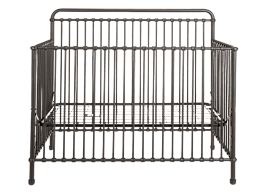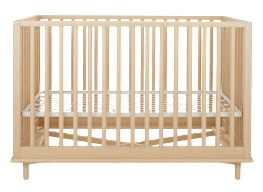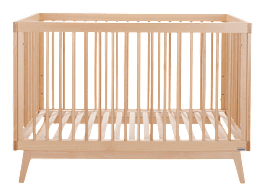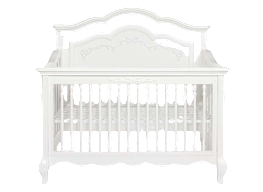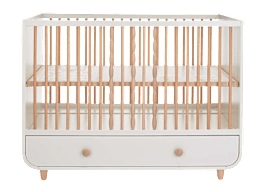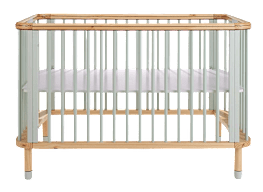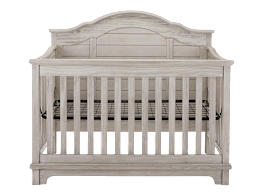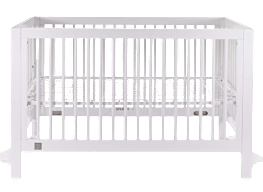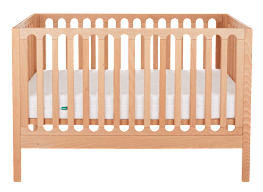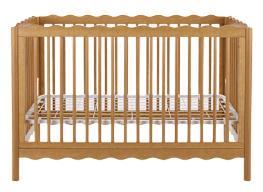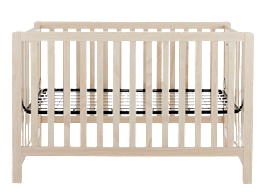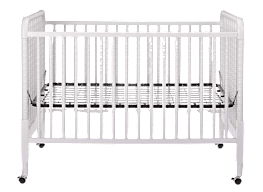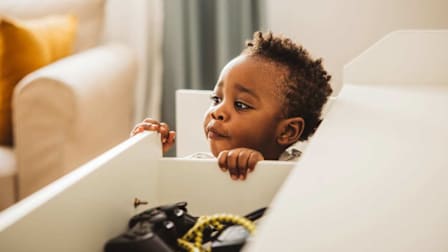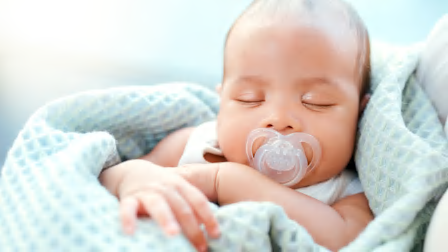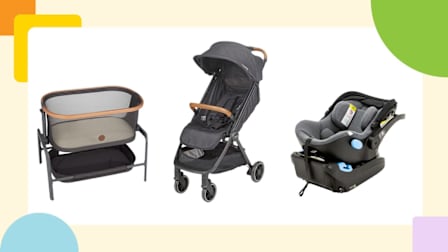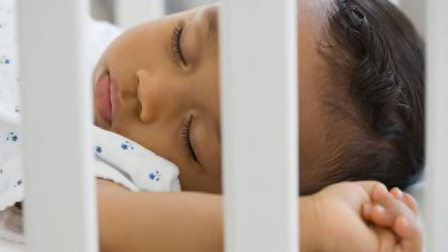Shopping for a Safe Crib? Consider These 5 Features Before You Buy.
When it comes to crib safety, here’s what CR's experts recommend. Plus, the safest cribs from our tests.
When you shop through retailer links on our site, we may earn affiliate commissions. 100% of the fees we collect are used to support our nonprofit mission. Learn more.
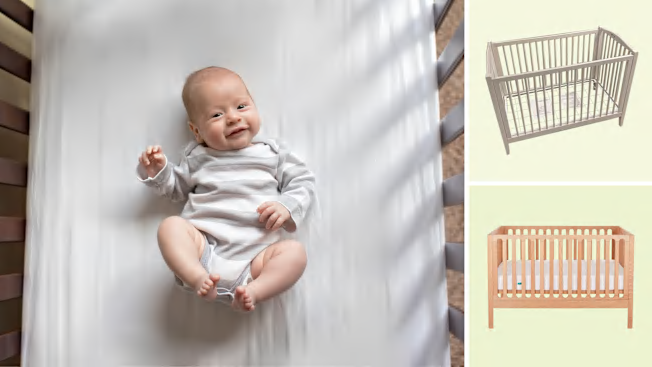
A crib is one of the most important purchases you’ll make as you prepare for your new baby. But how can you be sure the crib you choose for your little one is safe?
Rest assured that all cribs sold in the U.S. must meet federally regulated safety standards. If you’re using a new crib, the manufacturer must comply with the most recent safety regulations, which specify crib slat width, a strong mattress support, and fixed side rails (drop-side cribs were banned in 2011), as well as the type of paint or finish used, among other factors. Cribs and crib mattresses, just like bassinets, are held to strict safety standards for toxic chemicals, like lead and phthalates.
How CR Tests Cribs for Safety
In CR’s baby gear lab, we test cribs for safety, using the federal standard as a blueprint. “Of course, safety is most important, but we also look at how well made the crib is—after all, your baby will be spending a lot of time in it, and you may want to use it for more than one child,” says Joan Muratore, the engineer who oversees CR’s cribs and bassinets testing, which is why CR also tests for how easy a crib is to assemble, and how easy it is to change mattress height settings. Muratore and her group of product testers spend 4 to 5 weeks checking each crib in our assessment for the level of the crib sleeping surface, the strength of the mattress supports, the type of hardware and other materials used, and any surface defects, plus how many steps it takes to assemble the crib (and whether it can be assembled by just one person), and how many steps it takes to change the mattress height (crucial as your baby grows), along with the overall sturdiness and design of the crib.
Read our review of the best cribs, which includes models from DaVinci, Nestig, Newton, Pottery Barn, Stokke, West Elm, and other brands.
5 Safety Features to Look For in a Crib
1. Easy Assembly
You’re probably familiar with the unique frustration of putting together a piece of furniture with directions that are sparse at best. Apart from saving unnecessary stress while you’re setting up your baby’s nursery, having a crib that’s easy to put together is also a big factor in safety.
Reducing the number of steps and parts and including easy-to-follow instructions lowers the potential for error when assembling a crib, ultimately making it a safer place for your baby to sleep. “A crib that has a jillion steps of assembly can be exhausting, and it’s easier to make a mistake, like putting a part in the wrong orientation (hello, hard-to-decipher instruction illustrations) and not realizing it until you get farther on in the process, which is annoying,” says Muratore. “A crib that is easy to assemble is a definite confidence boost for parents who may be nervous—you want to be sure you’ve done it correctly.” Knowing that every screw or washer has its right place, and you put it there? That satisfaction is priceless.
2. Excellent Construction Quality
The top-ranking crib in CR’s tests earns its high marks from its superb construction quality and design. In our comparative testing, we take into account the materials used in the crib, the type of mattress support and how it’s attached to the frame, and the design of the crib.
Our testers also examine every crib we purchase for defects like inconsistencies in the finish. (CR buys every product we test at retail just like consumers do, and we do not accept free samples from brands, in order to ensure the veracity of the products we test.) A crib is meant to last through your child’s preschool years and beyond, because many cribs convert into a toddler bed or twin bed. If the painted surface is already chipping, will it flake off enough that your baby might ingest it? Will an uncovered screw head snag their pajamas or scratch their sensitive skin? Will the mattress support withstand your toddler’s newfound love of jumping? The crib you choose should hold up to normal wear and tear, and it should continue to be safe for years to come.
3. A Snug-Fitting Mattress
A firm, tight-fitting crib mattress is essential so that your baby’s head or limbs don’t get trapped between the edge of the mattress and the crib’s side rails, the Consumer Product Safety Commission says. “Crib mattresses aren’t sold with the crib, but separately,” says Nancy Cowles, child product safety expert and former executive director of the child product safety nonprofit Kids In Danger. “Both mattresses and cribs have standardized dimensions to prevent issues with poorly fitting mattresses.”
The CPSC specifies that a crib’s interior should be 28 inches wide by 52 3/8 inches long, with a 5/8-inch allowance for variation, and the mattress should measure at least 27 1/4 inches wide and 51 5/8 inches long, and should be no more than 6 inches thick. A standard-sized crib mattress should fit inside your crib snugly, with no more than two-fingers’ width of wiggle room on one side when the mattress is pushed firmly into one corner on the opposite side. “Try to pick the biggest mattress you can when they are all lined up at the store—it will fit more snugly in the crib,” says Cowles.
A firm crib mattress is also a must-have for safe sleep. It should be supportive enough not to sag beneath your baby’s weight because a soft sleeping surface could increase the risk of suffocation.
4. Adjustable Mattress Heights
As your baby grows and develops, they’ll learn new skills, like rolling over, pushing up on their hands and knees, and pulling up and cruising along furniture. As they grow, you’ll need to lower the height of your crib’s mattress supports so that the mattress sits lower to the ground, giving your little explorer more room to safely roam, without the risk of falling or climbing out.
You should use your crib’s highest mattress height until your baby can sit up (usually around 5 to 7 months), at which point you should lower the mattress to the middle setting. Once your baby can pull up to stand (often around 9 to 10 months), you’ll need to use the crib mattress’s lowest setting.
Almost all cribs come with adjustable mattress heights, but we rate cribs for how easy they make it for caregivers to use them. Do you have to disassemble much of the crib just to lower the mattress? That could introduce a safety risk when you’re trying to put it back together. Ideally, a crib will have an easily accessible and adjustable mattress height so that you won’t have to worry about a big undertaking when it’s time.
5. No Extra Items, Like Bumpers, Sleep Positioners, Monitors With Dangling Wires, or Toys
To serve as a safe place for your baby to sleep, a crib should be pretty bare: just a fitted sheet covering the mattress—and nothing else. Crib bumpers and sleep positioners can increase the risk of suffocation if your baby accidentally rolls over in their sleep. Crib side rail covers might protect against teething damage to your crib walls but could also pose a suffocation risk if they fall off. Mobiles can be a sweet addition to a nursery, but it’s safest not to place them directly above a crib, where they could fall or be pulled by reaching hands.
Also important is where you place your crib: Make sure to keep it a safe distance from any potential hazards, like window blinds, curtain ties, or cords. Cowles says that corded window treatments should never be used in a nursery or any other room that young children frequent, given the strangulation risk. And if you’re mounting a baby monitor with a view into your little one’s crib, be sure to fully secure any wires or cords well out of reach, too. “Monitors should not be mounted within 3 feet of a crib unless the cord is covered in a sheath or casing,” says Cowles. She also says that any electrical cords should be stowed behind a dresser and secured to a wall. And as a reminder, any dressers, wardrobes, or large shelves should also be secured to a wall to prevent tip-over risk.
Safest Cribs From CR's Tests
Are Used Cribs Safe?
Cribs are expensive, and it’s tempting to save money on this big-ticket item by picking up a crib from your local secondhand shop or receiving a hand-me-down from a family member or friend. But a used crib is not without safety risks. Because safety standards are regularly evaluated and updated, the crib you’re considering may not meet the latest regulations. Without knowing the crib’s history, there’s no way to tell how many times it was assembled and disassembled, or whether any hardware is missing, which could affect its construction. Is the mattress starting to sag from years of use? It may not be firm enough for your baby’s safety. Were the required safety labels removed? Those are necessary for ensuring safe sleep practices among all your baby’s caregivers.
But if a secondhand crib is still your best option, first look up the crib’s manufacturer and model name on the CPSC’s SaferProducts.gov to check for any recalls before you use it. You can also contact the manufacturer to request missing parts or safety labels, or a new copy of the manual, if necessary.
Crib Safety Guidelines
The AAP recommends using a crib, bassinet, or portable play yard as a safe sleeping environment for your baby, and recommends room-sharing for at least the first 6 months. Follow these safe sleep guidelines when using a crib for every nap and nighttime sleep.
- Always place your baby down on their back in their own sleeping space, with no other people or pets.
- Babies should sleep on a firm, flat—not inclined—surface. Inclines of 10 degrees or greater can restrict your baby’s airflow.
- Use only a fitted sheet in your baby’s sleeping space.
- Keep toys, blankets, bumpers, pillows or nursing pillows, baby loungers, sleep positioners, stuffed animals, and other items out of the crib. These items can potentially suffocate your baby. (Bumpers are banned under the Safe Sleep for Babies Act.)
- Do not use weighted sleep sacks.
- Make sure that any mobiles, monitor wires, curtain ties, or blind cords are out of reach.
- If your baby falls asleep in a car seat, stroller, swing, or infant carrier, you should move them to a firm sleep surface on their back as soon as possible.
For more safe sleep recommendations, contact your pediatrician.

















